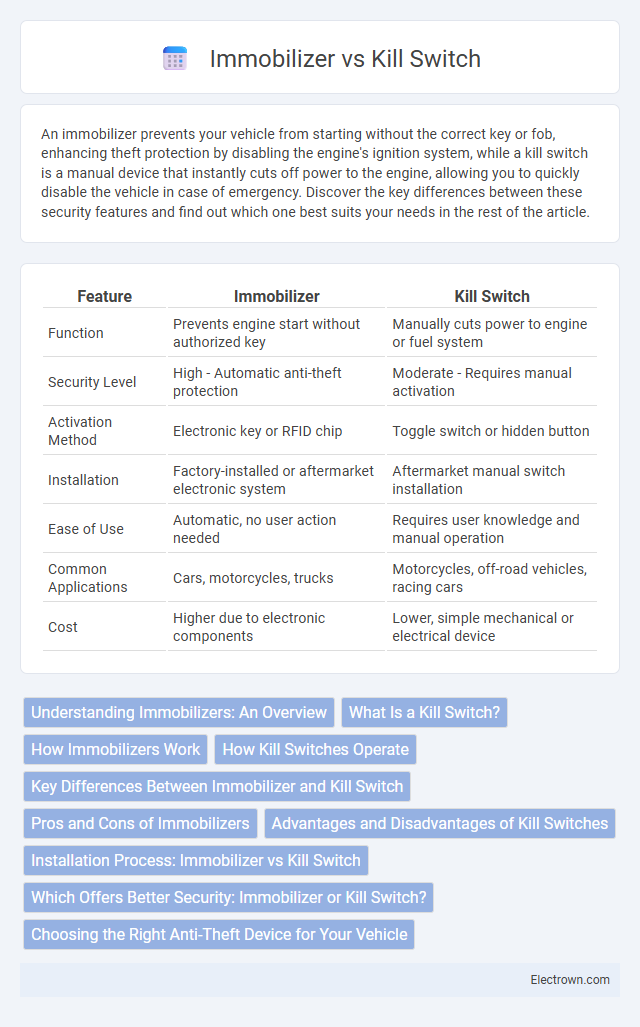An immobilizer prevents your vehicle from starting without the correct key or fob, enhancing theft protection by disabling the engine's ignition system, while a kill switch is a manual device that instantly cuts off power to the engine, allowing you to quickly disable the vehicle in case of emergency. Discover the key differences between these security features and find out which one best suits your needs in the rest of the article.
Table of Comparison
| Feature | Immobilizer | Kill Switch |
|---|---|---|
| Function | Prevents engine start without authorized key | Manually cuts power to engine or fuel system |
| Security Level | High - Automatic anti-theft protection | Moderate - Requires manual activation |
| Activation Method | Electronic key or RFID chip | Toggle switch or hidden button |
| Installation | Factory-installed or aftermarket electronic system | Aftermarket manual switch installation |
| Ease of Use | Automatic, no user action needed | Requires user knowledge and manual operation |
| Common Applications | Cars, motorcycles, trucks | Motorcycles, off-road vehicles, racing cars |
| Cost | Higher due to electronic components | Lower, simple mechanical or electrical device |
Understanding Immobilizers: An Overview
Immobilizers are advanced electronic security devices integrated into vehicles to prevent unauthorized engine start by disabling critical systems such as the fuel supply or ignition. Unlike a kill switch, which requires manual activation, immobilizers operate automatically by communicating with a unique key or fob embedded with a transponder chip. Understanding how immobilizers work enhances your ability to protect your vehicle from theft through technology that seamlessly integrates with your car's security system.
What Is a Kill Switch?
A kill switch is a security device designed to immediately shut down your vehicle's engine, preventing unauthorized use or theft. Unlike an immobilizer that disables the engine's starting system electronically, a kill switch physically interrupts the power or fuel supply, making it an effective manual or automatic safety measure. This quick action feature enhances your vehicle's protection by stopping it instantly when triggered.
How Immobilizers Work
Immobilizers work by electronically preventing the engine from starting unless the correct key or token is detected, using transponder chips embedded in the key that communicate with the vehicle's engine control unit (ECU). When the ECU verifies the correct signal, it enables fuel injection and ignition systems, otherwise, it disables these critical functions. This technology significantly reduces vehicle theft by ensuring only authorized keys can activate the engine.
How Kill Switches Operate
Kill switches operate by interrupting the electrical circuit of a vehicle, preventing the engine from starting or running. They are often manually activated through a hidden switch or button, instantly cutting off power to crucial components such as the ignition system or fuel pump. This direct disruption effectively immobilizes the vehicle, enhancing security against theft by requiring deliberate user intervention to restore operation.
Key Differences Between Immobilizer and Kill Switch
An immobilizer is an electronic security device integrated into your vehicle's ignition system, designed to prevent engine start without the correct key or transponder signal, thereby reducing theft risk. A kill switch, on the other hand, is a manual or automatic device that immediately cuts off the engine's power supply or fuel flow, stopping the vehicle from running in emergencies or unauthorized situations. Understanding these key differences ensures you select the right anti-theft solution or safety feature tailored to your vehicle's security needs.
Pros and Cons of Immobilizers
Immobilizers enhance vehicle security by preventing engine ignition without the correct key, significantly reducing theft rates; however, their electronic components can sometimes malfunction, leading to costly repairs and potential inconvenience. They offer seamless integration with modern car systems, ensuring minimal user effort while providing high security, but reliance on electronic signals makes them vulnerable to sophisticated hacking methods. Despite their reliability, immobilizers may complicate second-hand car sales due to key programming requirements and can occasionally fail to recognize authorized keys.
Advantages and Disadvantages of Kill Switches
Kill switches provide immediate engine shutdown, enhancing theft prevention by cutting power instantly, but they can be accidentally triggered, leading to unexpected vehicle stalls. Unlike immobilizers that electronically prevent engine start, kill switches require manual activation, which may reduce convenience and increase the risk of user error. Their simplicity and cost-effectiveness contrast with immobilizers' complexity and higher installation expenses, making kill switches a practical albeit less sophisticated security solution.
Installation Process: Immobilizer vs Kill Switch
The installation process of an immobilizer typically involves integrating electronic components with the vehicle's ignition system, requiring professional programming of key transponders to ensure proper authentication. In contrast, installing a kill switch is generally simpler, involving a manual switch wired into the fuel line or ignition circuit to physically disable the engine, allowing for more straightforward DIY installation. Both methods improve vehicle security, but immobilizers demand more technical expertise and precise calibration during setup compared to the mechanical nature of kill switches.
Which Offers Better Security: Immobilizer or Kill Switch?
Immobilizers provide superior security by electronically preventing engine start unless the correct key or fob signal is detected, making unauthorized use much harder. Kill switches physically interrupt the electrical circuit but can be bypassed if the location or mechanism is discovered by thieves. Immobilizers integrate advanced encryption and vehicle-specific coding, significantly reducing the risk of vehicle theft compared to kill switches.
Choosing the Right Anti-Theft Device for Your Vehicle
Choosing the right anti-theft device for your vehicle depends on the level of security and convenience you need; immobilizers electronically prevent the engine from starting without the correct key, offering reliable theft deterrence with minimal user effort. Kill switches physically interrupt the electrical system or fuel supply, providing a manual method to stop unauthorized vehicle use but requiring user activation. Assess your vehicle's risk factors and your daily routine to decide whether the automatic protection of an immobilizer or the hands-on control of a kill switch best suits your security needs.
Immobilizer vs Kill switch Infographic

 electrown.com
electrown.com